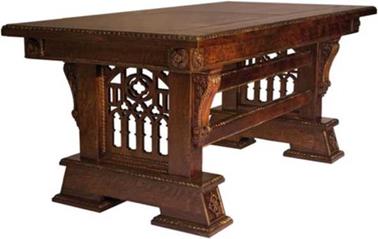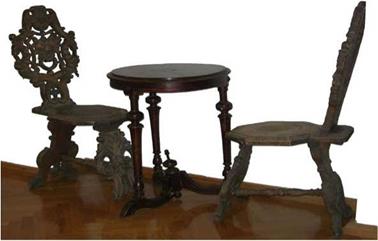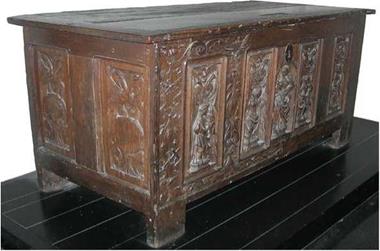1.4.1 Renaissance Furniture
When in Italy a new direction in artistic creativity appeared, which directed its inventiveness towards potential users, furniture achieved previously unencountered aesthetic and functional values. They ceased to be exclusively objects of common use and transformed into works of applied art just as attractive as sculptures or paintings. During this period, artists drew from the rich heritage of ancient culture, using woodworking techniques similar to those used by sculptors working with stone. Chairs with a cross-structure and richly decorated stools came to be widely used (Fig. 1.25).
During the Renaissance, the masters in furniture production were the Italians from Florence, Sienna, Lombardy and Venice. They mainly used the wood of the walnut tree, which they decorated by dyeing and finishing with wax The seats and
|
Fig. 1.24 Late Gothic table from the fifteenth-sixteenth century |
|
Fig. 1.25 Stools (Museum of the Radziwill family in Kiejdany) |
backrests of chairs were made as lattice, panel and frame panel structures, on which pillows or mattresses were placed, which were filled with hair and covered in leather, damask, velvet or gobelin fabric.
The most representative piece of furniture for lying on during the early Italian Renaissance period was a bed without a canopy, surrounded by steps in the form of chests. Later, the steps were completely integrated with the cases of the bed.
In some designs, the legs were massive columns protruding slightly over the surface of the bed, while others provide high support for canopies.
|
Fig. 1.26 Oak Renaissance chest, around 1520 (Victoria & Albert Museum, London) |
A distinctive piece of furniture for storage was the chest. In the fifteenth century, finishing touches in the form of cornices, pilasters and plinths became widely used. The side walls of the chest were decorated with pilasters or flattened consoles. The top of the chest was shut by a flat top decorated with a protruding cornice. In a later period, it was begun to divide the chests into individual fields by using side skirts, figural reliefs, cartouches, medallions, trophies and other similar elements (Fig. 1.26).
As it can be seen, the place for flat painting decorations and inlays used thus far is taken up by a deep relief sculpture, which with the exception of the top of the chest, covers all the visible walls completely. The Renaissance chest, like in the Gothic period, was used as furniture for sitting.
Under the influence of the Italian Renaissance, furniture workshops all over Europe were creatively developing. An original accomplishment of the French Renaissance was the armchair with a high backrest and armrests with a seat in the shape of a trapezium (Fig. 1.27). The chair was light, and hence easy to transfer and move. Of similar design were chairs intended for women and made like an armchair that was deprived of armrests.
Furniture manufactured in Spain stood out with the wealth of its fittings and ornamental pins, which were used to fix leathers or upholstery fabrics. A little different in character were the products made by the Netherlands artisans. They were distinguished by legs that were turned in two stages, with a larger diameter towards the connector and a smaller one from the connector downwards. The chairs of the German Renaissance are typical cross-structures made from two pairs of bent beam elements and crossed in the front plane.
Fig. 1.27 Caquetoire chair in France, sixteenth century (Gostwicka J.)






